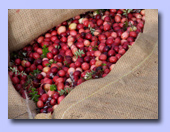 |
 |
 |
|
|
 |
What makes the cranberry a useful product worth growing? |
|
Lesson Plan: Overview
|
The berry that is associated with cranberry sauce and cranberry juice grows from a plant in the genus Vaccinum (Family, Ericaceae). This genus includes a wide variety of other fruit-bearing plants from all over the world, including the blueberry, the huckleberry, and the lingonberry. In fact, although it is thought that English colonists were unfamiliar with cranberries until their arrival on New England’s shores, the cranberry’s relative, the lingonberry, was well-known. The colonists were introduced to the cranberry’s usefulness by the Native Americans who not only ate the berry raw, but also used it in sauces, puddings, breads, and a high protein, “to go” meal called pemmican. Pemmican was a mixture of dried strips of meat or fish, fat, and berries that had been pounded into paste. The mixture was then shaped into a cake and dried in the sun. Pemmican stored well and was often used as a meal on long journeys. As it turns out, current research, such as that conducted by the University of Maine Pathogenic Microbiology Laboratory indicates that cranberry concentrate serves as a preservative. It inhibits food borne pathogens. Native Americans also used the cranberry to make dye for their rugs and blankets and found the cranberry plant to be valuable for medicinal purposes, using it both to treat wounds (as a poultice) and to help prevent certain illnesses. Ultimately, the Native American’s important berry also became a mainstay in the colonial home. Then, as now, different aspects of the cranberry fruit itself are related to its harvesting, processing, and uses, all of which depend in part on consumer and grower perspectives on what is valuable about the fruit. Taste: The characteristic tartness is indicative of its acidity, which in part comes from ascorbic acid —Vitamin C. Seafaring colonists recognized the berry’s ability to help stave off scurvy. The cranberry was a homegrown alternative to the limes used by British mariners. In this way, cranberries became an important American fruit that contributed to a European foothold on the continent, and colonial independence, as well. Touch: Touch a fresh, whole cranberry, and you will notice not just its round form, but also its smooth, waxy texture. This waxiness contributes to the cranberry’s longevity after it is picked from the vine. This characteristic allowed it to be packed in wooden barrels and brought on long sea journeys without spoiling, as well as contributing to winter food stores. Smell: What do you sense when you smell a whole fruit? Probably not much; the waxy coating prevents the berry from giving off much of a fragrance. Once cut, it gives off a smell that some have described as fruity or tart. Overall, compared to some fruits (bananas and oranges, for example), the smell might be considered by some to be subtle. Sight: Take a look at a fresh, ripe cranberry and you can appreciate its attractive, vibrant shade of red, which made it a desirable and convenient source of dye. Drop it in a glass of water, and you’ll see that it floats. This enables a method of harvesting (wet-harvest) that involves flooding the bog, and beating over the vines with a harvesting wheel. In this method, the berries are wrested free and float. Then they are corralled and gathered up for delivery to processing plants. Wet berries will mold if packaged right away, so these berries are traditionally used in processed cranberry products: juices, sauces, preserved (However in some regions—such as Wisconsin—wet harvested berries are dried and then packaged whole. Processing yields the pressed, cut cranberry skins, which were once discarded—until someone realized that they could be sweetened and dried for tasty dried cranberry snacks. Hearing: Drop a fresh, ripe, dry harvested whole cranberry on a wooden floor or cutting board, and you will both see and hear it bounce. Drop an old or damaged berry and it splats. While this may seem only to be a fun fact, in reality it impacts how berries are sorted, and which berries are processed. Fresh, whole cranberries are highly prized. Bouncing them down stairs used to be the method for selecting these desired specimens. (The discovery of this fact is attributed to John “Peg Leg” Webb, a New Jersey cranberry grower who, according to cranberry tradition, spilled a container of berries and realized he had a new method of sorting the valuable ones from the less prized.) Nowadays, sorters are based on this technique.
|
| Credits |